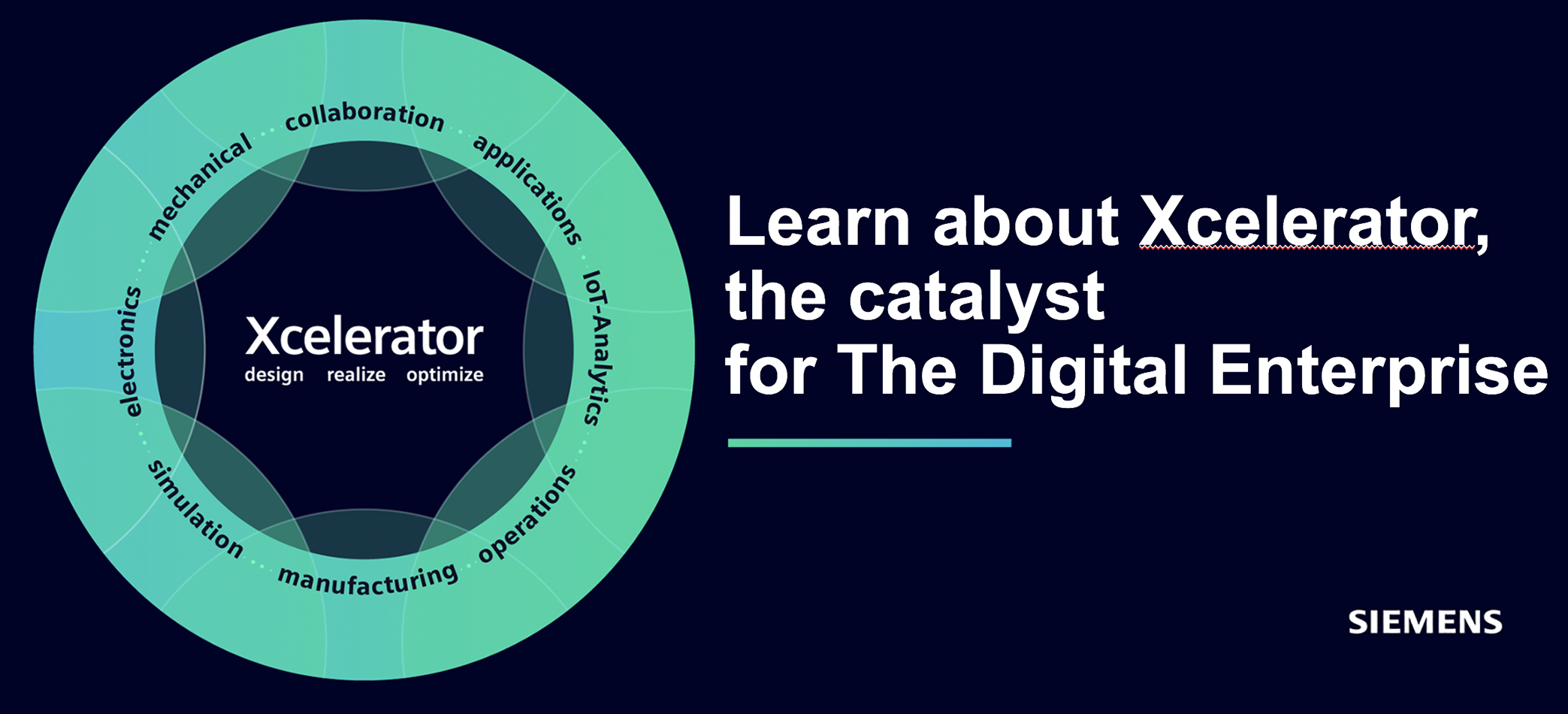Siemens på hugget under CES 2025: Innovationer inom industriell AI och digital tvillingar väcker...
”DET SOM HÄNDER I LAS VEGAS stannar inte nödvändigtvis i Las Vegas – det är CES 2025 beviset på…” Ett tidigt tecken på att vårsäsongen inom PLM, automation och allmänt när det gäller vass teknologiutveckling är den stora CES-mässan i Las Vegas, där alla med stora teknologi-ambitioner vill synas. När det startade idag, den 7 januari var Siemens en av de mest synliga aktörerna bland de stora PLM-spelarna. Flera saker stora saker är affischpelare för denna ledande PLM- och automationsspelare. Men inte överraskande är AI ett av de området man slår på trumman för. Bolagets styrelsemedlem, CTO och strategichef, Peter Koerte, berättade bl a om en vision för framtiden där data, AI och mjukvarudefinierad automation kommer att konvergera för att, ”möjliggöra oöverträffad flexibilitet, optimering och ständiga förbättringar över världens industrier, för företag av alla storlekar.” Stora ambitioner förstås och kärnan i Siemens närvaro vid CES 2025, ett av världens mest inflytelserika teknikevenemang. Siemens är, konstaterade Koerte inte utan goda anledningar, en global ledaren inom industriell mjukvara och pekade på att man nu tar än mer djärva steg i industriell innovation.
"Industriell AI är en spelomvandlare som kommer att skapa betydande positiva effekter i den verkliga världen inom alla branscher. Industriell AI låter oss utnyttja de enorma mängderna data som genereras i industriella miljöer och omvandla den till insikter som driver verklig affärseffekt. Vi lägger till nya industriella AI-kapaciteter i hela Siemens Xcelerator-portfölj för att göra det möjligt för våra kunder att förbli konkurrenskraftiga, motståndskraftiga och hållbara i en allt mer komplex värld", sa han.
Bland de bitar han specifikt noterade var att man nu tar Industrial AI direkt till verkstadsgolvet med den nya ”Industrial Copilot for Operations-lösningen”. Bland flera fördelar är att AI-uppgifter kan köras så nära maskiner som möjligt, via ”edge computing.” Detta underlättar snabbt beslutsfattande i realtid för operatörer och underhållsingenjörer, vilket ökar produktiviteten och minimerar stilleståndstiden. Industrial Copilots ekosystem utvecklas kontinuerligt för att erbjuda AI-kapacitet över hela den industriella värdekedjan och till sektorer som inkluderar diskret och processtillverkning, infrastruktur och mobilitet. Denna svit av copiloter kan förbättra samarbete mellan människa och maskin över alla erfarenhetsnivåer, vilket hjälper till att påskynda utvecklingstider och innovationscykler. Siemens Industrial Copilot kommer att integreras med Industrial Edge-ekosystemet, som har förbättrats med AI för att distribuera, driva och hantera AI-modeller inom produktionsmiljön.
Men här fanns mer på menyn; som Siemens NVIDIA-samarbete för att leverera fysiskt baserad visualisering för produktlivscykel-hantering, ett spännande kundsamarbete med startupen JetZero kring en flygplanslösning som banar väg mot netto-noll-drift via partitiell vätedrift, och samarbetet med Sony, som annonserades redan på CES ifjol, där bolagen nu levererar immersiva design-möjligheter med mixed-reality-headset och NX CAD-programvara i kombo.
Klicka på rubriken för att läsa hela reportaget kring Siemens på CES 2025.
"Industriell AI är en spelomvandlare som kommer att skapa betydande positiva effekter i den verkliga världen inom alla branscher. Industriell AI låter oss utnyttja de enorma mängderna data som genereras i industriella miljöer och omvandla den till insikter som driver verklig affärseffekt. Vi lägger till nya industriella AI-kapaciteter i hela Siemens Xcelerator-portfölj för att göra det möjligt för våra kunder att förbli konkurrenskraftiga, motståndskraftiga och hållbara i en allt mer komplex värld", sa han.
Bland de bitar han specifikt noterade var att man nu tar Industrial AI direkt till verkstadsgolvet med den nya ”Industrial Copilot for Operations-lösningen”. Bland flera fördelar är att AI-uppgifter kan köras så nära maskiner som möjligt, via ”edge computing.” Detta underlättar snabbt beslutsfattande i realtid för operatörer och underhållsingenjörer, vilket ökar produktiviteten och minimerar stilleståndstiden. Industrial Copilots ekosystem utvecklas kontinuerligt för att erbjuda AI-kapacitet över hela den industriella värdekedjan och till sektorer som inkluderar diskret och processtillverkning, infrastruktur och mobilitet. Denna svit av copiloter kan förbättra samarbete mellan människa och maskin över alla erfarenhetsnivåer, vilket hjälper till att påskynda utvecklingstider och innovationscykler. Siemens Industrial Copilot kommer att integreras med Industrial Edge-ekosystemet, som har förbättrats med AI för att distribuera, driva och hantera AI-modeller inom produktionsmiljön.
Men här fanns mer på menyn; som Siemens NVIDIA-samarbete för att leverera fysiskt baserad visualisering för produktlivscykel-hantering, ett spännande kundsamarbete med startupen JetZero kring en flygplanslösning som banar väg mot netto-noll-drift via partitiell vätedrift, och samarbetet med Sony, som annonserades redan på CES ifjol, där bolagen nu levererar immersiva design-möjligheter med mixed-reality-headset och NX CAD-programvara i kombo.
Klicka på rubriken för att läsa hela reportaget kring Siemens på CES 2025.
Siemens lanserar nytt program för att vässa nystartade företag med spetsteknologi
PLM- och CAx-mjukvara från XCELERATOR-portföljen en grundpelare i nytt startup-paket. Ett bra sätt att stödja innovativa startups med lovande teknologier är att i tidiga skeden erbjuda kvalificerade aktörer vassa, starkt rabatterade IT-lösningar, inte minst då när det gäller PLM-bitarna. Det som initialt kan handla om relativt små satsningar kan, om idéerna har genomslagskraft, växa till synnerligen stora installationer på med tiden normala kommersiella villkor. Detta har de flesta större PLM-utvecklarna i varierande omfattning tagit fasta på, men klart är att Siemens är en av de mest proaktiva spelarna på området.
När det stora konsument-elektronikeventet CES 2025 i Las Vegas startade idag (7 till 11 januari) passade bolaget på att lansera ett nytt sådant startup-program, ”Siemens for Stratups”. Programmet är särskilt intressant för nystartade rörelser inom konstruktion och tillverkning och går ut på att tillhandahålla lösningar för att effektivisera samarbetsprocesser och underlätta partnerskap med nya innovativa företag. Tillsammans med AWS, Amazon Web Services, Siemens kommer man att ge tillgång till Siemens Xcelerator ekosystem för att påskynda innovation för startups.
"Startups är avgörande för att göra våra kunder mer konkurrenskraftiga, hållbara och motståndskraftiga. Genom att samarbeta med startups hjälper Siemens till att föra banbrytande idéer till industrier snabbare, vilket ger kunderna möjlighet att hantera globala utmaningar mer effektivt med banbrytande teknologier, verktyg och lösningar", kommenterar Peter Koerte, styrelseledamot för Siemens AG, Chief Technology Officer och Chief Strategy Officer.
De som antas till programmet kommer att få tillgång till och kunna integrera Siemens omfattande svit av industriell mjukvara – inkluderat design-, simulerings- och tillverkningslösningar från Siemens Xcelerator-portföljen – inom ramen för AWS skalbara molninfrastruktur. På Xcelerator-plattformen finns bl a digitala spetsverktyg som NX CAD, simulerings- & analys-portföljen Simcenter och inte minst bolagets marknadsledande cPDm-mjukvara, Teamcenter. För teknisk support och go-to-market support kommer kvalificerade startups också att få AWS-krediter, affärsutvecklingsresurser och tillgång till AWS Activate-programmet.
Programmet har tre pelare:
• Hjälp att komma igång på Siemens Xcelerators marknadsplats.
• Siemens erbjuder också ett omfattande samarbete som ger startups tillgång till banbrytande kapacitet och tjänster som ger startups de tidiga intäkter som behövs för tillväxt.
• Och, som sagt, paketerad tillgång till viktiga mjukvaruverktyg från Siemens Xcelerator-portföljen.
Klicka på rubriken för att läsa mer på PLM&ERP News.
När det stora konsument-elektronikeventet CES 2025 i Las Vegas startade idag (7 till 11 januari) passade bolaget på att lansera ett nytt sådant startup-program, ”Siemens for Stratups”. Programmet är särskilt intressant för nystartade rörelser inom konstruktion och tillverkning och går ut på att tillhandahålla lösningar för att effektivisera samarbetsprocesser och underlätta partnerskap med nya innovativa företag. Tillsammans med AWS, Amazon Web Services, Siemens kommer man att ge tillgång till Siemens Xcelerator ekosystem för att påskynda innovation för startups.
"Startups är avgörande för att göra våra kunder mer konkurrenskraftiga, hållbara och motståndskraftiga. Genom att samarbeta med startups hjälper Siemens till att föra banbrytande idéer till industrier snabbare, vilket ger kunderna möjlighet att hantera globala utmaningar mer effektivt med banbrytande teknologier, verktyg och lösningar", kommenterar Peter Koerte, styrelseledamot för Siemens AG, Chief Technology Officer och Chief Strategy Officer.
De som antas till programmet kommer att få tillgång till och kunna integrera Siemens omfattande svit av industriell mjukvara – inkluderat design-, simulerings- och tillverkningslösningar från Siemens Xcelerator-portföljen – inom ramen för AWS skalbara molninfrastruktur. På Xcelerator-plattformen finns bl a digitala spetsverktyg som NX CAD, simulerings- & analys-portföljen Simcenter och inte minst bolagets marknadsledande cPDm-mjukvara, Teamcenter. För teknisk support och go-to-market support kommer kvalificerade startups också att få AWS-krediter, affärsutvecklingsresurser och tillgång till AWS Activate-programmet.
Programmet har tre pelare:
• Hjälp att komma igång på Siemens Xcelerators marknadsplats.
• Siemens erbjuder också ett omfattande samarbete som ger startups tillgång till banbrytande kapacitet och tjänster som ger startups de tidiga intäkter som behövs för tillväxt.
• Och, som sagt, paketerad tillgång till viktiga mjukvaruverktyg från Siemens Xcelerator-portföljen.
Klicka på rubriken för att läsa mer på PLM&ERP News.
Svenska energibolag investerar i hybrida moln för att följa NIS2-direktivet om IT- och driftsäkerhet
EU-omfattande LAGSTIFTNING om CYBERSÄKERHET ställer HÖGA KRAV på DRIFTSSÄKERHET för SAMHÄLLSKRITISKA VERKSAMHETER. Halmstad Energi och Miljö tar ett stort kliv framåt i sin IT-säkerhetsstrategi genom att implementera hybrid cloud-teknik och mikrosegmentering, som ett led i att följa det nya NIS2-direktivet. Direktivet, som är en EU-omfattande lagstiftning om cybersäkerhet, trädde i kraft i Sverige i september, ställer höga krav på säkerhet och driftssäkerhet för samhällskritiska verksamheter, som kommunala energibolag. Även Öresundskraft och andra kommunala energibolag gör liknande investeringar. Men hur kan hybrid cloud-teknik möta framtidens krav på IT- och driftssäkerhet?
PLM&ERP News har diskuterat saken med Jesper Ottosson, chef för IT-infrastruktur på Halmstad Energi och Miljö (HEM) och Hampus Berg, infrastruktur- och nätverkstekniker på HEM. I dagens intervju de delar sin syn på saken och vikten av robusta säkerhetslösningar och hur hybrid cloud-teknik kan möta framtidens krav säkerthets- och driftområdena.
”NIS2 är omfattande och det finns en viss osäkerhet kring vad exakt som krävs. Samtidigt är det en positiv utveckling som ger oss bättre kontroll och för upp IT-säkerhet till ledningsnivå. På sikt kommer det gynna alla,” säger Jesper Ottosson.
För att möta direktivets krav arbetar HEM aktivt med att separera sina IT-nätverk från OT-nätverk, operativ teknik i produktionssystemen. Målet är att minska risken för attacker som påverkar produktionskritiska system. Mikrosegmentering är en viktig del av detta. Det är en teknik som isolerar olika delar av IT-miljön från varandra för att förhindra så kallad lateral spridning, alltså skadlig kod som rör sig sidledes mellan applikationer.
”Med Nutanix Flow kan vi mikrosegmentera våra nätverk och även skapa en tydlig separation mellan IT- och OT-miljöer. Det här innebär att vi kan skydda våra äldre OT-enheter, som ofta har lägre säkerhetsstandarder, från hot utan att behöva byta ut hela den infrastrukturen,” förklarar Hampus Berg.
Till saken hör att Halmstad Energi och Miljö, som kommunens energi- och avfallsbolag har breda åtaganden att leva upp till. Bolaget levererar el, värme, kyla, sophantering och energitjänster till kommuninvånarna och förser såväl företag som privatpersoner med energi.
Klicka på rubriken för att läsa mer på PLM&ERP News.
PLM&ERP News har diskuterat saken med Jesper Ottosson, chef för IT-infrastruktur på Halmstad Energi och Miljö (HEM) och Hampus Berg, infrastruktur- och nätverkstekniker på HEM. I dagens intervju de delar sin syn på saken och vikten av robusta säkerhetslösningar och hur hybrid cloud-teknik kan möta framtidens krav säkerthets- och driftområdena.
”NIS2 är omfattande och det finns en viss osäkerhet kring vad exakt som krävs. Samtidigt är det en positiv utveckling som ger oss bättre kontroll och för upp IT-säkerhet till ledningsnivå. På sikt kommer det gynna alla,” säger Jesper Ottosson.
För att möta direktivets krav arbetar HEM aktivt med att separera sina IT-nätverk från OT-nätverk, operativ teknik i produktionssystemen. Målet är att minska risken för attacker som påverkar produktionskritiska system. Mikrosegmentering är en viktig del av detta. Det är en teknik som isolerar olika delar av IT-miljön från varandra för att förhindra så kallad lateral spridning, alltså skadlig kod som rör sig sidledes mellan applikationer.
”Med Nutanix Flow kan vi mikrosegmentera våra nätverk och även skapa en tydlig separation mellan IT- och OT-miljöer. Det här innebär att vi kan skydda våra äldre OT-enheter, som ofta har lägre säkerhetsstandarder, från hot utan att behöva byta ut hela den infrastrukturen,” förklarar Hampus Berg.
Till saken hör att Halmstad Energi och Miljö, som kommunens energi- och avfallsbolag har breda åtaganden att leva upp till. Bolaget levererar el, värme, kyla, sophantering och energitjänster till kommuninvånarna och förser såväl företag som privatpersoner med energi.
Klicka på rubriken för att läsa mer på PLM&ERP News.
X-mas & New Year’s Greetings From PLM&ERP News Team
To all the great people in the PLM, Automation and ERP Businesses – few can do so much to PROVIDE a BETTER WORLD than you. Technology and innovation mean a lot for human progress and all efforts and contributions are important. Thanks a lot for 2024 and let’s join forces for new exiting advancements during 2025.
All the best from Verdi Ogewell and PLM&ERP News' Editorial Team!
All the best from Verdi Ogewell and PLM&ERP News' Editorial Team!
Why the Codebeamer Purchase Can Develop to Become PTC’s Smartest Move in Years
“THE BEST of both worlds,” when MICROSOFT and VOLKSWAGEN together with PTC develop a generative AI-based Copilot for the ALM solution Codebeamer.
SOFTWARE/AUTOMOTIVE: One of the most interesting news on the PLM front in terms of software development this month is the announcement that PTC, Microsoft and Volkswagen Group are developing a copilot for generative AI based on PTC’s ALM solution Codebeamer. This copilot will support software development in physical products by enabling software engineers to create and manage product requirements more efficiently, as well as test, validate and release them.
The news raises the question of whether PTC’s purchase of Codebeamer in 2022 is not one of the company’s smartest moves in years. The solution was acquired by PTC, as part of the purchase of German Intland Software, and fits well into an industrial world where software has become a key domain. Not least on the automotive side where cars are increasingly living up to the image of “computers on four wheels,” or more correctly, SDVs (Software Defined Vehicles). How does PTC Codebeamer fit into this?
Mainly because it is a capable Application Lifecycle Management (ALM) solution for advanced software development. The open platform extends ALM functions with flexible configuration options for different product lines, thereby providing unique configurability in complex processes. Manufacturers are increasingly using software to differentiate their products and create different versions of them. In particular, car manufacturers require tightly integrated ALM and variant-based software management solutions to plan and deliver their different configurations.
On the user side, PTC's latest acquisition, Pure Systeme's pure::variants solution, plays a complementary role in the Codebeamer environment; manufacturing companies use this solution to manage different variants of software and system technology assets across their product configurations, especially in regulated industries such as automotive, aerospace and medical technology.
But now PTC, together with Microsoft and Volkswagen, is taking new development steps. They involve embedding generative AI via Microsoft Azure's AI capabilities. The background is that the VW Group made a decision in principle a little over a year ago that Codebeamer should be used to integrate, develop and cost-effectively maintain the increasingly complex software. The development of Codebeamer Copilot builds on VW's adoption of this ALM platform across all of the company's brands.
Undeniably a substantial order from the German automotive giant–which also owns the Audi, Porsche, Seat and Skoda brands–which can lead as far as desired, both technically and commercially. It is not just VW that is interested in Codebeamer…
"Microsoft Azure AI in the Codebeamer software can help us create new specifications and test cases. It can also improve the quality of our requirements by removing duplicates and checking against existing quality standards," says Robert Kattner, Head of IT Technology at the VW Group.
"The best of both worlds," says PTC's CPO, Kevin Wrenn.
Click on the headline to read more on PLM&ERP News.
The news raises the question of whether PTC’s purchase of Codebeamer in 2022 is not one of the company’s smartest moves in years. The solution was acquired by PTC, as part of the purchase of German Intland Software, and fits well into an industrial world where software has become a key domain. Not least on the automotive side where cars are increasingly living up to the image of “computers on four wheels,” or more correctly, SDVs (Software Defined Vehicles). How does PTC Codebeamer fit into this?
Mainly because it is a capable Application Lifecycle Management (ALM) solution for advanced software development. The open platform extends ALM functions with flexible configuration options for different product lines, thereby providing unique configurability in complex processes. Manufacturers are increasingly using software to differentiate their products and create different versions of them. In particular, car manufacturers require tightly integrated ALM and variant-based software management solutions to plan and deliver their different configurations.
On the user side, PTC's latest acquisition, Pure Systeme's pure::variants solution, plays a complementary role in the Codebeamer environment; manufacturing companies use this solution to manage different variants of software and system technology assets across their product configurations, especially in regulated industries such as automotive, aerospace and medical technology.
But now PTC, together with Microsoft and Volkswagen, is taking new development steps. They involve embedding generative AI via Microsoft Azure's AI capabilities. The background is that the VW Group made a decision in principle a little over a year ago that Codebeamer should be used to integrate, develop and cost-effectively maintain the increasingly complex software. The development of Codebeamer Copilot builds on VW's adoption of this ALM platform across all of the company's brands.
Undeniably a substantial order from the German automotive giant–which also owns the Audi, Porsche, Seat and Skoda brands–which can lead as far as desired, both technically and commercially. It is not just VW that is interested in Codebeamer…
"Microsoft Azure AI in the Codebeamer software can help us create new specifications and test cases. It can also improve the quality of our requirements by removing duplicates and checking against existing quality standards," says Robert Kattner, Head of IT Technology at the VW Group.
"The best of both worlds," says PTC's CPO, Kevin Wrenn.
Click on the headline to read more on PLM&ERP News.
Det bästa från två världar när MICROSOFT och VOLKSWAGEN tillsammans med PTC utvecklar en...
Mjukvarutveckling: Är KÖPET av Codebeamer 2022 ett av PTCs SMARTASTE DRAG hittills? En av månadens mest intressanta nyheter på PLM-fronten ifråga om mjukvarutveckling är beskedet att PTC, Microsoft och Volkswagen utvecklar en copilot för generativ AI baserad på PTC’s ALM-lösning Codebeamer. Denna copilot kommer att stödja mjukvaruutveckling i fysiska produkter genom att göra det möjligt för mjukvaruingenjörer att skapa och hantera produktkrav mer effektivt, samt testa, validera och releasa dem.
Nyheten väcker frågan är om inte PTCs köp av Codebeamer 2022 är ett av bolagets smartaste drag de senaste tio åren. Lösningen förvärvades av PTC, som en del i köpet av tyska Intland Software, och passar väl in i en industrivärld där mjukvara, tillsammans med el/elektronik (E/E), blivit en nyckeldomän. Inte minst på fordonssidan där bilar i allt högre grad lever upp till bilden av ”datorer på fyra hjul,” eller mer korrekt, SDVs (Software Defined Vehicles). Hur passar PTC Codebeamer in i detta?
Främst för att Codebeamer är en kapabel Application Lifecycle Management-lösning (ALM) för avancerad mjukvaruutveckling. Den öppna plattformen utökar ALM-funktioner med flexibla konfigurationsmöjligheter för olika produktlinjer och ger i detta en unik konfigurerbarhet i de komplexa processerna. Tillverkare använder sig allmänt alltmer av mjukvara för att differentiera sina produkter och för att skapa olika versioner av dem. I synnerhet biltillverkare kräver tätt integrerade ALM- och variantbaserade lösningar för mjukvaruhantering för att planera och leverera de olika konfigurationerna som driver deras utbud.
På användarsidan spelar f ö PTCs senaste köp, Pure Systemes pure::variants-lösning, en kompletterande roll i Codebeamer-miljön; tillverkningsföretag utnyttjar denna lösning för att hantera olika varianter av mjukvaru- och systemtekniska tillgångar över sina produktkonfigurationer. Framför allt då inom reglerade industrier som fordons-, flyg- och medicinteknik-marknaderna.
Men nu tar PTC alltså tillsammans med Microsoft och Volkswagen Group nya utvecklingssteg, som går ut på att man ska bädda in generativ AI via Microsoft Azures AI-kapabiliteter. Till bakgrunden hör att Volkswagen-koncernen för ett drygt år sedan tog ett principbeslut på en Codebeamer-satsning, där lösningen ska användas för att integrera, utveckla och kostnadseffektivt underhålla de allt komplexare mjukvarorna. Utvecklingen av Codebeamer Copilot bygger alltså på VWs upptag av ALM-plattformen över alla bolagets märken och fordonsprojekt.
Onekligen en substantiell beställning från den tyska fordonsjätten–som bl a också äger Audi-, Porsche-, Seat- och Skoda-märkena–som både tekniskt och kommersiellt kan leda hur långt som helst. Det är inte heller bara VW som är intresserade av Codebeamer…
I en kommentar säger Robert Kattner, chef för IT-teknik på VW Group: "Microsoft Azure AI i Codebeamer-mjukvaran kan hjälpa oss med att skapa nya specifikationer och testfall. Det kan också förbättra kvaliteten på våra krav genom att ta bort dubbletter och kontrollera mot befintliga kvalitetsstandarder.”
"Det bästa från två världar," säger PTCs CPO, Kevin Wrenn.
Klicka på rubriken för att läsa mer på PLM&ERP News.
Nyheten väcker frågan är om inte PTCs köp av Codebeamer 2022 är ett av bolagets smartaste drag de senaste tio åren. Lösningen förvärvades av PTC, som en del i köpet av tyska Intland Software, och passar väl in i en industrivärld där mjukvara, tillsammans med el/elektronik (E/E), blivit en nyckeldomän. Inte minst på fordonssidan där bilar i allt högre grad lever upp till bilden av ”datorer på fyra hjul,” eller mer korrekt, SDVs (Software Defined Vehicles). Hur passar PTC Codebeamer in i detta?
Främst för att Codebeamer är en kapabel Application Lifecycle Management-lösning (ALM) för avancerad mjukvaruutveckling. Den öppna plattformen utökar ALM-funktioner med flexibla konfigurationsmöjligheter för olika produktlinjer och ger i detta en unik konfigurerbarhet i de komplexa processerna. Tillverkare använder sig allmänt alltmer av mjukvara för att differentiera sina produkter och för att skapa olika versioner av dem. I synnerhet biltillverkare kräver tätt integrerade ALM- och variantbaserade lösningar för mjukvaruhantering för att planera och leverera de olika konfigurationerna som driver deras utbud.
På användarsidan spelar f ö PTCs senaste köp, Pure Systemes pure::variants-lösning, en kompletterande roll i Codebeamer-miljön; tillverkningsföretag utnyttjar denna lösning för att hantera olika varianter av mjukvaru- och systemtekniska tillgångar över sina produktkonfigurationer. Framför allt då inom reglerade industrier som fordons-, flyg- och medicinteknik-marknaderna.
Men nu tar PTC alltså tillsammans med Microsoft och Volkswagen Group nya utvecklingssteg, som går ut på att man ska bädda in generativ AI via Microsoft Azures AI-kapabiliteter. Till bakgrunden hör att Volkswagen-koncernen för ett drygt år sedan tog ett principbeslut på en Codebeamer-satsning, där lösningen ska användas för att integrera, utveckla och kostnadseffektivt underhålla de allt komplexare mjukvarorna. Utvecklingen av Codebeamer Copilot bygger alltså på VWs upptag av ALM-plattformen över alla bolagets märken och fordonsprojekt.
Onekligen en substantiell beställning från den tyska fordonsjätten–som bl a också äger Audi-, Porsche-, Seat- och Skoda-märkena–som både tekniskt och kommersiellt kan leda hur långt som helst. Det är inte heller bara VW som är intresserade av Codebeamer…
I en kommentar säger Robert Kattner, chef för IT-teknik på VW Group: "Microsoft Azure AI i Codebeamer-mjukvaran kan hjälpa oss med att skapa nya specifikationer och testfall. Det kan också förbättra kvaliteten på våra krav genom att ta bort dubbletter och kontrollera mot befintliga kvalitetsstandarder.”
"Det bästa från två världar," säger PTCs CPO, Kevin Wrenn.
Klicka på rubriken för att läsa mer på PLM&ERP News.
“Leading Radar and Real-Time Systems”: HEXAGON’s Latest Acquisition Accelerates the Journey to Fully AUTONOMOUS...
HEXAGON ACQUIRES INDURAD, a company at the forefront of radar and real-time location systems (RTLS). The deal, announced in late November, also includes Indurad’s autonomous transportation subsidiary, Xtonomy. This strategic move underscores Hexagon’s commitment to improving mining productivity, safety and autonomy through groundbreaking technology.
In the press release, the company points to several key benefits that the acquisition will bring, including:
• Enhanced Mine Safety: indurad’s advanced radar-based collision avoidance systems mitigate risks in high-stakes mining environments.
• Increased Productivity: Real-time ore tracking and measurement help automate mine workflows, reducing downtime and inefficiencies.
• Future-Ready Autonomy: indurad’s mobile machine automation expertise and OEM-agnostic autonomy platform combined with Hexagon’s existing technologies accelerate the shift to fully autonomous mines.
“This acquisition represents another step towards realising our vision of fully connected and integrated mine workflows,” said Norbert Hanke, Interim President and CEO of Hexagon. “Indurad’s radar technology aligns perfectly with our focus on safety and autonomy, and we are excited to integrate their capabilities into our portfolio to unlock its full potential.”
The acquired company is based in Germany and specializes in modular radar systems that deliver precise object tracking, collision avoidance and machine automation. These innovations, Hanke believes, will enhance Hexagon's integrated portfolio, "further strengthening its leadership in the mining industry."
The transaction is expected to close by the end of November, when Indurad will be fully consolidated into Hexagon's Autonomous Solutions division. In 2023, the company reported revenues of approximately EUR 19 million, but with profitability initially below Hexagon Group levels. However, this is expected to improve as synergies are realized. The company has 140 employees globally.
Click on the headline to read the full article on PLM&ERP News.
In the press release, the company points to several key benefits that the acquisition will bring, including:
• Enhanced Mine Safety: indurad’s advanced radar-based collision avoidance systems mitigate risks in high-stakes mining environments.
• Increased Productivity: Real-time ore tracking and measurement help automate mine workflows, reducing downtime and inefficiencies.
• Future-Ready Autonomy: indurad’s mobile machine automation expertise and OEM-agnostic autonomy platform combined with Hexagon’s existing technologies accelerate the shift to fully autonomous mines.
“This acquisition represents another step towards realising our vision of fully connected and integrated mine workflows,” said Norbert Hanke, Interim President and CEO of Hexagon. “Indurad’s radar technology aligns perfectly with our focus on safety and autonomy, and we are excited to integrate their capabilities into our portfolio to unlock its full potential.”
The acquired company is based in Germany and specializes in modular radar systems that deliver precise object tracking, collision avoidance and machine automation. These innovations, Hanke believes, will enhance Hexagon's integrated portfolio, "further strengthening its leadership in the mining industry."
The transaction is expected to close by the end of November, when Indurad will be fully consolidated into Hexagon's Autonomous Solutions division. In 2023, the company reported revenues of approximately EUR 19 million, but with profitability initially below Hexagon Group levels. However, this is expected to improve as synergies are realized. The company has 140 employees globally.
Click on the headline to read the full article on PLM&ERP News.
”Vassa radar- och realtidssystem”: HEXAGON och köpet som accelererar färden mot helt AUTONOMA GRUVOR
HEXAGON KÖPER INDURAD, ett företag som ligger långt framme inom radar- och realtidslokaliserings-system (RTLS). I affären ingår också Indurads dotterbolag för autonoma transporter, Xtonomy. Detta strategiska drag understryker Hexagons engagemang för att förbättra gruvområdets produktivitet, säkerhet och autonomi genom banbrytande teknik.
I pressmaterialet pekar bolaget på flera viktiga fördelar som köpet för med sig, bl a:
• Förbättrad gruvsäkerhet: Indurads avancerade radarbaserade system för undvikande av kollisioner minskar riskerna i gruvmiljöer med hög insats.
• Ökad produktivitet: Malmspårning och mätning i realtid hjälper till att automatisera gruvarbetsflöden, vilket minskar stilleståndstid och ineffektivitet.
• Framtidsklar autonomi: Indurads expertis inom mobil maskinautomation och OEM-agnostiska autonomiplattform i kombination med Hexagons befintliga teknologier påskyndar övergången till helt autonoma gruvor.
"Det här köpet representerar ytterligare ett steg mot att förverkliga vår vision om helt uppkopplade och integrerade gruvarbetsflöden", säger Norbert Hanke, interim CEO och koncernchef för Hexagon."Indurads radarteknologi passar perfekt in i vårt fokus på säkerhet och autonomi, och vi är glada över att integrera deras kapacitet i vår portfölj för att frigöra dess fulla potential."
Det förvärvade bolaget är baserat i Tyskland och är specialiserat på modulära radarsystem som levererar exakt objektsspårning, undvikande av kollisioner och maskinautomatisering. Dessa innovationer, menar Hanke, kommer att förbättra Hexagons integrerade portfölj, ”vilket ytterligare stärker dess ledarskap inom gruvindustrin.”
Transaktionen förväntas avslutas i slutet av november, då Indurad kommer att konsolideras helt i Hexagons division för autonoma lösningar. Under 2023 rapporterade bolagets intäkter ligga på cirka 19 miljoner euro, men då med en lönsamhetm som initialt ligger under Hexagon Group-nivåer. Men detta förväntas kunna förbättras när synergier realiseras. Företaget har 140 anställda globalt.
Klicka på rubriken för att läsa mer på PLM&ERP News.
I pressmaterialet pekar bolaget på flera viktiga fördelar som köpet för med sig, bl a:
• Förbättrad gruvsäkerhet: Indurads avancerade radarbaserade system för undvikande av kollisioner minskar riskerna i gruvmiljöer med hög insats.
• Ökad produktivitet: Malmspårning och mätning i realtid hjälper till att automatisera gruvarbetsflöden, vilket minskar stilleståndstid och ineffektivitet.
• Framtidsklar autonomi: Indurads expertis inom mobil maskinautomation och OEM-agnostiska autonomiplattform i kombination med Hexagons befintliga teknologier påskyndar övergången till helt autonoma gruvor.
"Det här köpet representerar ytterligare ett steg mot att förverkliga vår vision om helt uppkopplade och integrerade gruvarbetsflöden", säger Norbert Hanke, interim CEO och koncernchef för Hexagon."Indurads radarteknologi passar perfekt in i vårt fokus på säkerhet och autonomi, och vi är glada över att integrera deras kapacitet i vår portfölj för att frigöra dess fulla potential."
Det förvärvade bolaget är baserat i Tyskland och är specialiserat på modulära radarsystem som levererar exakt objektsspårning, undvikande av kollisioner och maskinautomatisering. Dessa innovationer, menar Hanke, kommer att förbättra Hexagons integrerade portfölj, ”vilket ytterligare stärker dess ledarskap inom gruvindustrin.”
Transaktionen förväntas avslutas i slutet av november, då Indurad kommer att konsolideras helt i Hexagons division för autonoma lösningar. Under 2023 rapporterade bolagets intäkter ligga på cirka 19 miljoner euro, men då med en lönsamhetm som initialt ligger under Hexagon Group-nivåer. Men detta förväntas kunna förbättras när synergier realiseras. Företaget har 140 anställda globalt.
Klicka på rubriken för att läsa mer på PLM&ERP News.
”A Digital Milestone”: EPLAN and Siemens Establish Seamless Compatibility in Machine Engineering
ABB, TESLA and SpaceX among EPLAN's users. When it comes to software and service solutions in electrical engineering, automation and mechatronics, German EPLAN is undoubtedly one of the more prominent players. The company specializes above all in machine, line and panel builders. Not least for this reason, today's announced extended collaboration with Siemens Digital Industries Software is of great interest: The companies are deepening the collaboration and connections between EPLAN's software and the Siemens Xcelerator portfolio. They thereby significantly increase the compatibility between their products. It is generally about automated interactions between Siemens Teamcenter X software and TIA Portal on the one hand, and EPLAN Electric P8 and Pro Panel on the other.
A heavy point is that all technical information now becomes available directly in EPLAN and vice versa; in other words, factors that allow you to directly benefit from a more efficient tool chain for machine and line technology, which also contributes to the fact that the electrical work can be done much faster and the risks of errors are reduced.
In the press material, it is pointed out that the collaboration on both sides expands the companies' partner ecosystem: Siemens Xcelerator's open digital business platform and EPLAN's Partner Network. The effects are as follows:
• Seamless data exchange between Siemens Teamcenter X, TIA-Selection Tool and EPLAN's software
• Collaboration improves the tool chain in mechanical engineering
• Machine builders can realize their projects in construction, operation and expansion faster and more efficiently.
"The partnership between Siemens and EPLAN is a milestone in digital technology. The optimized data exchange makes it possible to realize your projects in construction, operation and expansion faster and more efficiently," says Cedrik Neike, board member of Siemens AG and CEO of Digital Industries. "Through this collaboration, we strengthen the Siemens Xcelerator ecosystem and create greater value for customers than any of us could do individually."
EPLAN's CEO, Sebastian Seitz adds:
"With this collaboration, Eplan and Siemens combine their broad experiences in mechanical engineering to provide our joint customers with comprehensive tool chain. This makes engineering processes much faster and less prone to errors."
Companies using EPLAN include well-known players such as ABB, Tesla, Neilsoft, Bachner Elektro and SpaceX.
Click on the headline to read more on PLM&ERP News.
Click on the headline to read more on PLM&ERP News.
”En digital milstolpe”: EPLAN och Siemens etablerar sömlöst kompatibel maskinteknik
ABB, TESLA och SpaceX bland EPLANs användare. När det gäller mjukvaru- och servicelösningar inom elektroteknik, automation och mekatronik är tyska EPLAN tveklöst en av de mer framstående aktörerna. Bolaget spetsar framför allt för maskin-, linje- och panelbyggare. Inte minst av detta skäl är dagens annonserade utökade samarbete med Siemens Digital Industries Software av stort intresse: Bolagen fördjupar samarbetet och kopplingarna mellan EPLANs programvaror och Siemens Xcelerator portfölj. Man utökar därmed kompatibiliteten avsevärt mellan sina produkter. Det handlar övergripande om automatiserade interaktioner mellan Siemens Teamcenter X-mjukvara och TIA Portal å ena sidan, och EPLAN Electric P8 och Pro Panel å den andra.
En tung poäng är att all teknisk information nu blir tillgänglig direkt i EPLAN och vice versa; alltså faktorer som gör att man direkt kan dra nytta av en effektivare verktygskedja för maskin- och linjeteknik, vilket också bidrar till att det eltekniska arbetet kan göras mycket snabbare och riskerna för fel minskar.
I pressmaterialet pekar man på att samarbetet på båda sidor utökar bolagens partner-ekosystem: Siemens Xcelerators öppna digitala affärsplattform och EPLANs Partner Network. Effekterna blir följande:
• Sömlöst datautbyte mellan Siemens Teamcenter X, TIA-Selection Tool och EPLANs programvaror
• Samarbete förbättrar verktygskedjan inom maskinteknik
• Maskinbyggare kan förverkliga sina projekt inom konstruktion, drift och utbyggnad snabbare och effektivare.
"Partnerskapet mellan Siemens och EPLAN är en milstolpe inom digital teknik. Det optimerade datautbytet gör det möjligt för att kunna realisera sina projekt inom byggnation, drift och utbyggnad snabbare och effektivare", säger Cedrik Neike, styrelseledamot för Siemens AG och CEO för Digital Industries. "Genom detta samarbete förstärker vi Siemens Xcelerator-ekosystemet och skapar ett större värde för kunderna, än vad var och en av oss skulle kunna göra individuellt."
EPLANs CEO, Sebastian Seitz tillägger:
"Med detta samarbete slår EPLAN och Siemens ihop sina breda erfarenheter inom maskinteknik för att ge våra gemensamma kunder och heltäckande verktygskedja. Detta gör ingenjörsprocesser mycket snabbare och mindre benägna för fel."
Bland företag som använder EPLAN finns välkända spelare som ABB, Tesla, Neilsoft, Bachner Elektro och SpaceX.
En tung poäng är att all teknisk information nu blir tillgänglig direkt i EPLAN och vice versa; alltså faktorer som gör att man direkt kan dra nytta av en effektivare verktygskedja för maskin- och linjeteknik, vilket också bidrar till att det eltekniska arbetet kan göras mycket snabbare och riskerna för fel minskar.
I pressmaterialet pekar man på att samarbetet på båda sidor utökar bolagens partner-ekosystem: Siemens Xcelerators öppna digitala affärsplattform och EPLANs Partner Network. Effekterna blir följande:
• Sömlöst datautbyte mellan Siemens Teamcenter X, TIA-Selection Tool och EPLANs programvaror
• Samarbete förbättrar verktygskedjan inom maskinteknik
• Maskinbyggare kan förverkliga sina projekt inom konstruktion, drift och utbyggnad snabbare och effektivare.
"Partnerskapet mellan Siemens och EPLAN är en milstolpe inom digital teknik. Det optimerade datautbytet gör det möjligt för att kunna realisera sina projekt inom byggnation, drift och utbyggnad snabbare och effektivare", säger Cedrik Neike, styrelseledamot för Siemens AG och CEO för Digital Industries. "Genom detta samarbete förstärker vi Siemens Xcelerator-ekosystemet och skapar ett större värde för kunderna, än vad var och en av oss skulle kunna göra individuellt."
EPLANs CEO, Sebastian Seitz tillägger:
"Med detta samarbete slår EPLAN och Siemens ihop sina breda erfarenheter inom maskinteknik för att ge våra gemensamma kunder och heltäckande verktygskedja. Detta gör ingenjörsprocesser mycket snabbare och mindre benägna för fel."
Bland företag som använder EPLAN finns välkända spelare som ABB, Tesla, Neilsoft, Bachner Elektro och SpaceX.















